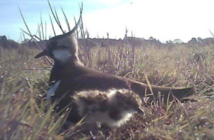Field bean volunteer crops …
Following difficult autumn sowing conditions and high autumn and winter rainfall, many growers are enquiring about the risks and potential of keeping volunteer field bean crops for production.
There are clear risks associated with following beans with beans, most related to pest and disease development, as well as difficulty controlling weeds – particularly blackgrass. There are several pests and diseases that should be considered when deciding whether to keep volunteers.
PGRO does not advise maintaining volunteer beans as crops, although we recognise that it may appear to provide some financial and operational benefits, and the following is guidance about the risks associated with this approach:
- Stem and bulb nematodes
Stem and bulb nematodes (Ditylenchus spp.) are soil and seed-borne pests, infesting land for up to ten years. Each time beans are sown there is potential to increase levels of the pest in soils, and once identified it is advisable to leave those fields uncropped with beans for ten years.
Infested seed is a primary means of introducing the pest onto farms and damage is caused to crops by the development and multiplication of nematodes in stem tissue. This leads to plant distortion, thickening of stems and leaves, discolouration of stem and leaf tissue, staining of seed and in severe cases, significant yield losses.
In volunteer crops, seed will not have been tested for presence of stem and bulb nematodes, and previously unidentified problems have the potential to be multiplied significantly when following beans with beans.
It is possible to test plant tissue for the presence of nematodes via our advisory plant clinic and it would be advisable to do so if you feel there are no options other than keeping volunteers. We advise that if nematodes are found field bean volunteers should be destroyed and alternative cropping plans made.
- Disease incidence
For several reasons, disease incidence in volunteer crops is likely to be greater than in a field bean crop drilled within a normal rotation of 5 years. There is no opportunity for inoculum levels to fall between bean crops, and there is likely to be direct carry-over from the previous bean crop, particularly of chocolate spot and rust, the beans providing a living bridge for those diseases.
Volunteer crops often emerge earlier than an autumn-sown winter bean crop, and often plant stand can be dense compared to the usual establishment rate of 18-20 plants per square metre. In addition, plant stand may be variable across a field.
Research has shown that the combination of early autumn emergence and dense crops provides good conditions for early, high levels of chocolate spot development and some volunteer crops are already showing high levels of disease. Rust may overwinter on bean foliage, providing an early source of disease that can develop quickly in warm conditions.
Soil-borne diseases such as foot rot (Fusarium spp.) and downy mildew, may develop quickly in volunteer crops and cause significant yield loss at or before flowering stage. The continued build-up of these diseases in soils may then lead to greater problems when beans are next cropped in the rotation.
- Weed control
Volunteer crops won’t have received a pre-emergence herbicide and there are limited options from this point forward. Whether they are spring or winter varieties the planting date means they are all winter beans. Therefore, products such as Crawler may be an option provided no side shoots have developed, and it is applied before the end of February.
Crawler mainly controls grass weeds, offering some black grass activity but little broad-leaved weed activity. The only remaining option is a post-emergence application of bentazone. However, volunteer crops may be past the latest permissible development stage of 7 unfolded leaves (BBCH 17) when conditions are warm and bright enough to get satisfactory control from a bentazone application. Be mindful that bentazone is extremely soluble and there are water stewardship guidelines relating to bentazone that advise applications should not be made before April 1st.
Overall, the risk of problems arising in volunteer beans is high, and often these risks may not be realised until it is too late in the season to find a suitable alternative.
Advice on spring drilling beans …
When planning the sowing rate of spring beans and peas, the optimum plant density for spring beans is 45-55 plants per sq m established. Use the following to calculate seed rate (Allow for a 5-10% seed bed loss):
| Seed Rate (kg/ha) = | Required population x thousand seed weight x | 100 |
| % germination | 100 – seed bed loss |
The Optibean tool will help you to calculate optimum field bean seed rates for your farm and is available at www.pgro.org. Refer to PGRO Crop Update CB1911 (6th November 2019) for guidance about drilling winter beans in the spring.
Don’t rush planting – it’s better to wait for good soil conditions rather than try to stick to calendar dates.
If possible, choose varieties with good downy mildew resistance. Downy mildew is a soil-borne disease that can affect yield and quality. Details of the relative resistance to downy mildew can be found in the PGRO Pulse Recommended List of peas, available at www.pgro.org.




